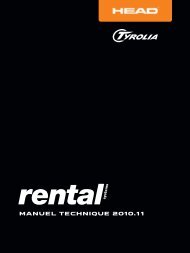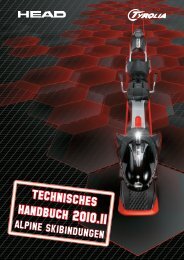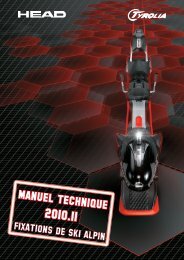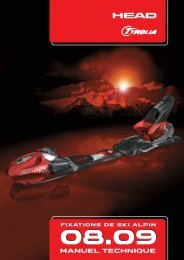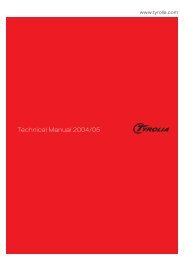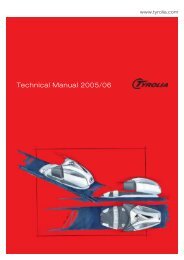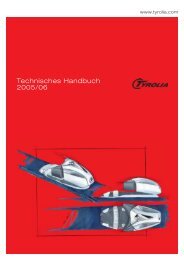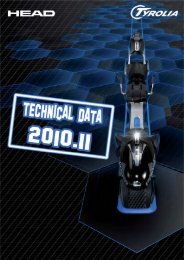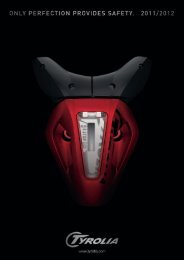Create successful ePaper yourself
Turn your PDF publications into a flip-book with our unique Google optimized e-Paper software.
46 | Rental Ski Binding Rental Ski Binding | 46<br />
in the manner specified by the device manufacturer.<br />
TEST RESULT OR RELEASE TORQUE<br />
The middle quantitative value of three tests made in<br />
the same direction.<br />
PRE-SEASON TEST<br />
REFERENCE BOOT SELECTION<br />
The Reference Boot is a boot of a designated sole length<br />
which is otherwise typical of the boot inventory.<br />
Use the procedure below if the boot inventory includes<br />
several models and a representative boot can not easily<br />
be identified.<br />
1. Select five single boots with sole lengths as specified<br />
in Table [A] and [B] for the binding type to be<br />
tested: adult, junior, child, or BYS or B2YS. 2. Clean all five boots with a mild detergent and water.<br />
3. Adjust a rental binding to the release indicator<br />
setting specified in Table [A] for the binding type.<br />
4. Fit the binding to the boot and determine the<br />
Release Torque in all three directions of release<br />
(forward lean and both directions in twist-three<br />
releases in each direction).<br />
5. Average the Release Torque for CW (clockwise) and<br />
CCW (counter clockwise) twist release.<br />
6. Reject and replace any boot with a CW to CCW<br />
difference of more than 6 Nm for adult boots or<br />
4 Nm when testing child boot types.<br />
7. Rank the five twist results and select, as the Reference<br />
Boot for twist, the middle boot.<br />
8. Rank the five forward lean results and select, as<br />
the Reference Boot for forward lean, the middle<br />
boot.<br />
PRE-SEASON BINDING INSPECTION<br />
The procedure that follows is an integral part of preseason<br />
maintenance. It is also a good way to determine<br />
if maintenance and which units have outlived their use<br />
fullness and must be removed from inventory.<br />
1. Clean areas of the bindings that contact the boot<br />
and perform all preseason binding maintenance.<br />
2. Visually or manually check:<br />
a.) AFD condition.<br />
b.) Brakes function.<br />
c.) Release indicator readability and travel.<br />
d.) Screw tightness.<br />
F<br />
Skier Code<br />
Binding<br />
Type<br />
Children<br />
Sole<br />
length<br />
mm<br />
270 mm<br />
Release<br />
Indicator<br />
J Junior 306 mm 4.5 45 Nm 175 Nm<br />
Setting<br />
Reference<br />
Torque<br />
3. Adjust each binding with the reference boot, then<br />
adjust the release value indicators to the specified<br />
value found in table [A].<br />
Due to the fixed length of BYS bindings there is an<br />
adapted table for BYS and B2YS system bindings<br />
(table [B], [C], [D]).<br />
4. Check that the heel track and toe track SINGLE<br />
CODE agree with the sole length Single Code of the<br />
reference boot.<br />
5. With the Reference Boot in the binding, verify<br />
elastic travel of the toe piece by striking the boot<br />
toe with a mallet or dead hammer and checking<br />
that the toe piece returns the boot quickly and<br />
completely to center.<br />
6. Verify elastic travel of the heel piece by lifting the<br />
boot while depressing the heel piece cocking lever<br />
and checking that the heel piece returns the boot<br />
quickly and completely to the latched position.<br />
7. <strong>Manual</strong>ly release the binding 3 times in each<br />
direction.<br />
8. Lubricate all boot/binding interfaces with a mild<br />
liquid detergent and water solution.<br />
9. With the Ski Binding Test Device determine the<br />
Release Torque for each direction of release (forward<br />
lean and both directions in twist).<br />
10. Record “PASS” in the bindings maintenance record<br />
if Test Results are within the Inspection Range<br />
provided in table [A].<br />
11. Set the ski aside if the Test result in any directions<br />
of release is outside the Inspection Range in table<br />
[A].<br />
12. Follow Troubleshooting Procedure on page 30 for<br />
units which have been set aside and retest if changes<br />
in the unit’s condition or adjustment are made.<br />
13. Record “FAIL” in the binding’s maintenance record<br />
if, after troubleshooting, test results in any direction<br />
of release are outside the In-Use Range.<br />
Replace the “failed” unit and retest before returning<br />
the ski to service.<br />
14. If after troubleshooting, Test Results are outside<br />
the Inspection Range but within the In-Use Range,<br />
apply a Correction Factor to the unit and note the<br />
Correction Factor for that unit in the binding’s maintenance<br />
record.<br />
15. If many bindings fail, check the test device and<br />
re-inspect the Reference Boot. If necessary, select<br />
another boot and retest the bindings.<br />
38–52 Nm 149–201 Nm<br />
L Adult 327 mm 6.0 60 Nm 239 Nm 51–69 Nm 203–275 Nm<br />
Twist Nm<br />
Reference<br />
Torque<br />
Forward Nm<br />
Twist<br />
Inspection<br />
Range Nm<br />
Table [A] Pre-season Binding Inspection<br />
Forward<br />
Inspection<br />
Range Nm<br />
Twist In-<br />
Use Range<br />
31–59 Nm<br />
42–78 Nm<br />
Forward In-<br />
Use Range<br />
Nm<br />
2.5 25 Nm 94 Nm 21–29 Nm 80–108 Nm 17.5–33 Nm 66–122Nm<br />
122–228 Nm<br />
167–311 Nm



